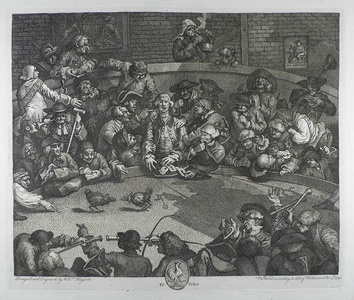| Method | Copper engraving and etching |
| Artist | William Hogarth |
| Published | Design'd and Engrav'd by Willm. Hogarth. Publish'd according to Act of Parliament Nov. 5th 1759. [J & J Boydell c.1795] |
| Dimensions | Image 315 x 375 mm, Plate 320 x 390 mm, Sheet 475 x 645 mm |
| Notes |
A view of a cock-fight, taking place at the Royal Cockpit in Birdcage Walk at St James' Park. The print itself is emblazoned at the bottom with a crest, as if it were itself a 'Royal Sport Pit Ticket.' The scene is a raucous one, though centred on the figure of a peer, Lord Albemarle Bertie, the second son of the Second Duke of Ancaster. As Paulson has illustrated, the blind figure of Bertie is positioned alongside his fellow spectators, gamblers, and wastrels in the same manner as Christ amongst his disciples in Da Vinci's Last Supper, a motif that occurs in a number of Hogarth's works, most prominently Columbus Breaking the Egg. Unseen by Bertie, one man steals a note from his hat while others clamour to accept or reject bets on the fight. To one side, the enthusiastic spectators have rushed towards the ring, knocking the wig off a man in the front row and almost crushing him under them. On the other, a pair of French dandies look on in amusement and horror alternatively, one turning his back in disgust, while another nonchalantly reaches for his snuff, spilling some on the man in front who sneezes violently. At the back of the arena, a dog watches the cocks, the wall behind it showing the Royal Crest of the Order of the Garter and a portrait of Nan Rawlings, a notable cock-trainer of the day. The cocks themselves have been trimmed for the fight, their combs and wattles removed and their feathers clipped. A shadow falls on the ground of the ring, indicating a man suspended in a basket, a common punishment for defaulting on bets. In the foreground, two betters bump their riding crops together to agree upon a bet, while a drunk holds up his purse, unaware of another's attempt to snatch it from him with a hooked cane. William Hogarth (1697 - 1764) was born in London, the son of an unsuccessful schoolmaster and writer from West moreland. After apprenticeship to a goldsmith, he began to produce his own engraved designs in about 1710. He later took up oil painting, starting with small portrait groups called conversation pieces. He went on to create a series of paintings satirising contemporary customs, but based on earlier Italian prints, of which the first was The Harlot's Progress (1731), and perhaps the most famous The Rake's Progress. His engravings were so plagiarised that he lobbied for the Copyright Act of 1735, commonly referred to as 'Hogarth's Act,' as a protection for writers and artists. During the 1730s Hogarth also developed into an original painter of life-sized portraits, and created the first of several history paintings in the grand manner. Paulson 206 i/i, BM Satires 3706 Condition: Water stain to left side of sheet, not affecting image or plate, some surface dirt and toning. |
| Framing | unmounted |
| Price | £375.00 |
| Stock ID | 38132 |

